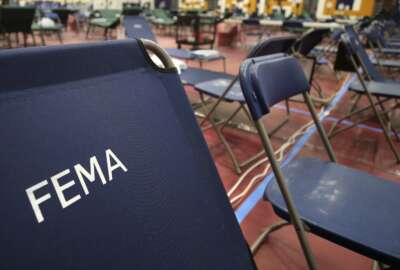
This is only a test. Or is it? An update on the National Public Warning System
The Department of Homeland Security has issued new guidance to operators of the National Public Warning System, who are distributed throughout the U.S. The guidance...
Best listening experience is on Chrome, Firefox or Safari. Subscribe to Federal Drive’s daily audio interviews on Apple Podcasts or PodcastOne.
The Department of Homeland Security has issued new guidance to operators of the National Public Warning System, who are distributed throughout the U.S. The guidance is how to protect the system from electromagnetic pulses or EMP, whether caused by sunspots or a nuclear detonation. The guidance was a joint effort of several DHS components. For details, the Federal Drive with Tom Temin spoke to Brent Talbot, Science and Technology Directorate program manager Brent Talbot. They first discuss: Why EMP and why now?
Interview transcript:
Brent Talbot: EMP and all of that came about back in the 1960s, at least the awareness of it. The IPAWS system was one that’s developed by FEMA. And that’s the Integrated Public Alert and Warning System. And it’s part of the Emergency Broadcast System. As we all know, as we’ve listened to the radio, and again, it’s interrupted every now and then for tests of that system. FEMA developed a dual enclosure system that sits next to about 77 radio stations around the country. And what it’s designed to do is take over in the case of EMP or another natural disaster, and enable the president to get out the messages to the American public in the case of emergencies, and so it reaches about 90% of the population. And they developed the system to withstand an EMP and we were fortunate to work with them to test that system against that eventuality or possibility.
Tom Temin: And as you imply this was not strictly a Homeland Security S&T gambit to create these recommendations, you work closely with the Cybersecurity and Infrastructure Security Agency.
Brent Talbot: Absolutely. CISA works with the other components within DHS to help us understand the full scope of the requirements. We work with our colleagues there. And we were very fortunate to work with FEMA to help them with the testing of the iPod system. And so together we were able to come up with the recommendations that are put forth in that report that we published.
Tom Temin: So FEMA, CISA and S&T.
Brent Talbot: Absolutely, it’s all one great big DHS family team, whatever you want to call it.
Tom Temin: And on the topic of EMP itself, what’s the issue with it, now? If the infrastructure shown to be protected against EMP, sounds like everything’s OK.
Brent Talbot: Yes, as a matter of fact, the testing that we did was successful, the testing and the system worked well. So we’re hopeful that it will withstand whatever it gets thrown at it.
Tom Temin: You’ve got a series of recommendations, though, for local agencies, federal agencies, and of course, the people that are in the private sector that operate this as radio stations. In fact, our sister station, WTOP, is one of those 77 that has the box that you described, what do we have to do next, then?
Brent Talbot: What we use the testing of the IPAW System to help us do is to write those recommendations, as you indicated, and this is primarily for the owners and operators have the critical infrastructure that we have: the electric grid, the power stations, the water treatment plants, those kinds of things. So we came up with some recommendations about seven of them, to put out to those owners and operators to help them devise what it is they need to do to protect themselves against an electromagnetic pulse
Tom Temin: From the Emergency Broadcast System, the way that is protected provides lessons that other people with other pieces of infrastructure that have electronics in them could also learn then to protect those systems from EMP.
Brent Talbot: Absolutely. And among those recommendations, look at your system for what vulnerabilities does it have against something that’s going to affect your circuitry, or electric power or something along those. Determine what kind of approach you want to use to protect those things. And then what systems are you dependent on? What are the requirements that you have for do you have to have someone attending the system, can it be a standalone all by itself? And then protect the points of entry from an electromagnetic pulse or something like that, then to develop your operational procedures, what are you going to do if that kind of disaster happens, and then as with any system, you need to inspect it, whatever you’re using to protect that, maintain it, make sure that it’s in good working order, and then train using your own operational procedures. And practice on that. Do exercises. Make sure that your people know what they’re doing. And make sure that, you know, for example, if you’ve got your equipment that’s most vulnerable in a cabinet, make sure you always keep the cabinet door closed. You know simple things like that.
Tom Temin: We’re speaking with Brent Talbot. He’s a program manager at the Homeland Security Department’s Science and Technology Directorate. What are the sources of EMP that we should worry about the most again, going back to the 50s and 60s, an atomic explosion as a source of emp, but in recent years, I guess we realize it can or more recent years than that, it can come from the sunspots, or from other sources directed against the United States that are not nuclear explosions?
Brent Talbot: You bring up a great point, the ones that we are looking at primarily are those high altitude, thermonuclear explosions. Those are the manmade. And you talked about the sunspot, those are naturally occurring, not all of them are intense enough, of course to reach the Earth. And those that do reach the Earth, not not all of them are intense enough that they have a negative impact on our critical infrastructure. But those are the two main things that we’re looking at the manmade and then of course, the natural, which is actually called a geomagnetic disturbance. But it has a lot of the same effects of an EMP, so we clump those together.
Tom Temin: But anything that produces enough induction to really wreck a circuit could be considered an EMP effect?
Brent Talbot: Right. Absolutely. But most of those are smaller in intensity, and they’re not going to affect a very large swath of the country. Whereas a GMD or a manmade EMP would have the possibility of affecting a larger swath.
Tom Temin: But are their sources now that we are aware of, say, from rival or enemy nations that can produce an EMP that could do damage? But it’s not a thermonuclear explosion?
Brent Talbot: Of course, yes, you can create the electronics into a mechanism where you could do that. The problem with that is, is we would probably, I would hope, be able to detect that equipment being manufactured, being put together. What we’re doing right now is we’re concentrating on the the two bigger ones that would have the greater impact on a wider area. But yes, I mean, there are other mechanisms like that folks can do that have a nefarious intent against us that you can do that.
Tom Temin: But if you’re protected against a thermonuclear explosion, you’re probably protected against anything else someone could launch?
Brent Talbot: Absolutely, as long as I mentioned before, you are maintaining the equipment, or the the mitigation factors that you’ve put in place correctly, that you’re the cabinet that you’ve got your electronics in, you’re keeping the door closed, you’re you’re keeping the equipment in an internal room.
Tom Temin: Do you have a sense of how industry that provides critical network infrastructure, such as banking, finance, retail and so on, they have data centers, and they have data services, airlines, you could go on and on, is that something that they generally think about in designing data centers and planning for continuity of operations? EMP?
Brent Talbot: I think that in a lot of cases, they are going to think about similar things, maybe not an electromagnetic pulse, but they are thinking about natural disasters that can occur and they’re going to, again, they’re gonna put their data centers in a zone that’s not going to be prone to flooding or earthquakes or something of that nature, they’re going to put them in a very, in an interior room, they’re going to put some of the factors into place that will also help protect against an EMP. But one of the things that we’re trying to do is raise awareness of the EMP threat, and make sure that folks have the recommendations that they can use to mitigate against it. And then we also want to make sure that incident reporting and recovery from those events are also are occurring, and that we can make recommendations for those as well.
Tom Temin: And what about cloud computing facilities? They must have that as part of their operation, because they’re standalone buildings, you drive by them, and they have lots of security. Is EMP in your understanding something that that they are concerned with, also?
Brent Talbot: Yes, it should be. We’re trying to work with all of the, and CISA has a great component within DHS that does that, that works with the critical infrastructure folks, and with the other departments within government, and works within the different components within DHS to help make sure that information is out there that those folks are aware of it that the critical infrastructure is as well protected as we can recommend it be in that we don’t regulate that, but we can certainly make the recommendations based on for example, like the testing we did on the IPAW system,
Tom Temin: And you don’t need to have a lead roof in order to be protected against EMP.
Brent Talbot: No, I’m not sure that lead would be the proper material. But certainly if you’re familiar with a Faraday cage, you could certainly build one around your critical components, your house, your data center or whatever. Although something like that would be a little bit more expensive to do. It just depends on what do you think is worth the time and energy to do.
Tom Temin: Right. So the best outcome then would be an EMP ineffective against everything except Bitcoin mining centers. That’s a joke.
Brent Talbot: Well, you know, again, we’re dealing with the critical infrastructure and Bitcoin mining probably doesn’t fit in that category.
Tom Temin: Brent Talbot is a program manager at the Homeland Security Science and Technology Directorate. Thanks so much for joining me
Brent Talbot: Been a pleasure. Thank you for having us.
Copyright © 2025 Federal News Network. All rights reserved. This website is not intended for users located within the European Economic Area.
Tom Temin is host of the Federal Drive and has been providing insight on federal technology and management issues for more than 30 years.
Follow @tteminWFED





